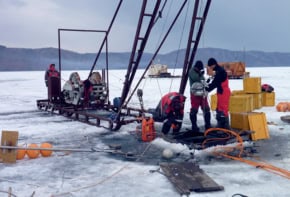
CERN has released a statement to confirm that the OPERA collaboration has identified a feature of its experiment that could explain its puzzling superluminal-neutrino discovery – a faulty optical fibre. The collaboration is now investigating this, and one other potential source of error, and it plans to carry out new experimental runs in May.
In September last year, the OPERA collaboration at the Gran Sasso underground lab in central Italy sent shockwaves through the physics community. Its researchers revealed that they had observed neutrinos fired from the CERN particle-physics lab near Geneva that appeared to have travelled 730 km to the Italian lab at speeds exceeding the speed of light. The announcement made headlines around the world because it appears to contradict Einstein’s special theory of relativity.
At the time, the OPERA collaboration calculated a confidence level of “6σ”, or a one-in-a-billion chance that the result was a statistical fluke. The results were described in a paper submitted to the arXiv preprint server. However, the collaboration also made it clear that OPERA researchers would continue to scrutinize all aspects of the experiment in a search of systematic errors; in other words, oversights in the experimental set-up. Now, it appears that they may have found their error.
The problem relates to the way that data are transmitted within the experiment. Neutrino speeds are estimated by dividing the baseline distance travelled (as calculated using GPS measurements) by the time-of-flight (as calculated using an atomic clock). The researchers have now realized that an optical fibre connecting the GPS signal to the atomic clock may not have been functioning correctly at the time when the measurements were made. This could have led to an underestimate of the time taken by neutrinos on their journey.
However, the situation is not quite this straightforward. The researchers have also identified another potential source of error that could push the result in the other direction – suggesting that the neutrinos were travelling even faster. This error could be related to an oscillator used to provide timestamps for GPS synchronizations, which could have led to an overestimate of the neutrinos’ journey times.
“The OPERA collaboration has informed its funding agencies and host laboratories that it has identified two possible effects that could have an influence on its neutrino timing measurement,” reads the CERN statement. “The potential extent of these two effects is being studied by the OPERA collaboration. New measurements with short pulsed beams are scheduled for May.”



